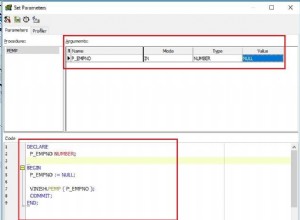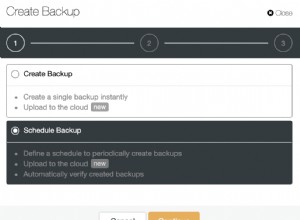Sie müssen Api schreiben, wo Sie die Daten von Android übergeben und diese Daten in Api abrufen und mit der Insert-Abfrage in der Datenbank speichern können. Auf der Android-Seite müssen Sie den folgenden Code ausführen:
Meine Klasse PutUtility für getData(), PostData, DeleteData(). Sie müssen nur den Paketnamen ändern
package fourever.amaze.mics;
import java.io.BufferedReader;
import java.io.IOException;
import java.io.InputStreamReader;
import java.io.OutputStreamWriter;
import java.io.UnsupportedEncodingException;
import java.net.HttpURLConnection;
import java.net.URL;
import java.net.URLConnection;
import java.net.URLEncoder;
import java.util.HashMap;
import java.util.Map;
public class PutUtility {
private Map<String, String> params = new HashMap<>();
private static HttpURLConnection httpConnection;
private static BufferedReader reader;
private static String Content;
private StringBuffer sb1;
private StringBuffer response;
public void setParams(Map<String, String> params) {
this.params = params;
}
public void setParam(String key, String value) {
params.put(key, value);
}
public String getData(String Url) {
StringBuilder sb = new StringBuilder();
try {
// Defined URL where to send data
URL url = new URL(Url);
URLConnection conn = null;
conn = url.openConnection();
// Send POST data request
httpConnection = (HttpURLConnection) conn;
httpConnection.setRequestProperty("Content-Type", "application/x-www-form-urlencoded");
httpConnection.setRequestMethod("GET");
BufferedReader in = new BufferedReader(
new InputStreamReader(httpConnection.getInputStream()));
String inputLine;
response = new StringBuffer();
while ((inputLine = in.readLine()) != null) {
response.append(inputLine);
}
in.close();
} catch (IOException e) {
e.printStackTrace();
} finally {
try {
reader.close();
} catch (Exception ex) { }
}
return response.toString();
}
public String postData(String Url) {
StringBuilder sb = new StringBuilder();
for (String key : params.keySet()) {
String value = null;
value = params.get(key);
if (sb.length() > 0) {
sb.append("&");
}
sb.append(key + "=" + value);
}
try {
// Defined URL where to send data
URL url = new URL(Url);
URLConnection conn = null;
conn = url.openConnection();
// Send POST data request
httpConnection = (HttpURLConnection) conn;
httpConnection.setRequestProperty("Content-Type", "application/x-www-form-urlencoded");
httpConnection.setRequestMethod("POST");
httpConnection.setDoInput(true);
httpConnection.setDoOutput(true);
OutputStreamWriter wr = null;
wr = new OutputStreamWriter(conn.getOutputStream());
wr.write(sb.toString());
wr.flush();
BufferedReader in = new BufferedReader(
new InputStreamReader(httpConnection.getInputStream()));
String inputLine;
response = new StringBuffer();
while ((inputLine = in.readLine()) != null) {
response.append(inputLine);
}
in.close();
} catch (IOException e) {
e.printStackTrace();
} finally {
try {
reader.close();
} catch (Exception ex) {
}
}
return response.toString();
}
public String putData(String Url) {
StringBuilder sb = new StringBuilder();
for (String key : params.keySet()) {
String value = null;
try {
value = URLEncoder.encode(params.get(key), "UTF-8");
if (value.contains("+"))
value = value.replace("+", "%20");
//return sb.toString();
// Get the server response
} catch (UnsupportedEncodingException e) {
e.printStackTrace();
}
if (sb.length() > 0) {
sb.append("&");
}
sb.append(key + "=" + value);
}
try {
// Defined URL where to send data
URL url = new URL(Url);
URLConnection conn = null;
conn = url.openConnection();
// Send PUT data request
httpConnection = (HttpURLConnection) conn;
httpConnection.setRequestProperty("Content-Type", "application/x-www-form-urlencoded");
httpConnection.setRequestMethod("PUT");
httpConnection.setDoInput(true);
httpConnection.setDoOutput(false);
OutputStreamWriter wr = null;
wr = new OutputStreamWriter(conn.getOutputStream());
wr.write(sb.toString());
wr.flush();
reader = new BufferedReader(new InputStreamReader(conn.getInputStream()));
;
String line = null;
// Read Server Response
while ((line = reader.readLine()) != null) {
// Append server response in string
sb1.append(line + " ");
}
// Append Server Response To Content String
Content = sb.toString();
} catch (IOException e) {
e.printStackTrace();
} finally {
try {
reader.close();
} catch (Exception ex) {
}
}
// Send PUT data request
return Url;
}
public String deleteData(String Url) {
StringBuilder sb = new StringBuilder();
for (String key : params.keySet()) {
try {
// Defined URL where to send data
URL url = new URL(Url);
URLConnection conn = null;
conn = url.openConnection();
// Send POST data request
httpConnection = (HttpURLConnection) conn;
httpConnection.setRequestProperty("Content-Type", "application/x-www-form-urlencoded");
httpConnection.setRequestMethod("DELETE");
httpConnection.connect();
reader = new BufferedReader(new InputStreamReader(conn.getInputStream()));
String line = null;
// Read Server Response
while ((line = reader.readLine()) != null) {
// Append server response in string
sb1.append(line + " ");
}
// Append Server Response To Content String
Content = sb.toString();
} catch (IOException e) {
e.printStackTrace();
} finally {
try {
reader.close();
} catch (Exception ex) {
}
}
}
return Url;
}
Und verwenden Sie diese Klasse so. Diese Klasse stellt automatisch eine Internetverbindung her und gibt Ihnen eine Antwort vom Server:
private class ServiceLogin extends AsyncTask<String, Void, String> {
ProgressDialog mProgressDialog;
private String res;
@Override
protected void onPreExecute() {
mProgressDialog = ProgressDialog.show(LoginActivity.this,
"", "Please wait...");
}
@Override
protected String doInBackground(String... params) {
res = null;
PutUtility put = new PutUtility();
put.setParam("UserId", params[0].toString());
put.setParam("Latitude", params[1].toString());
put.setParam("Longitude", params[2].toString());
put.setParam("DateTime", params[3].toString());
try {
res = put.postData("INSERT URL of API HERE");
Log.v("res", res);
} catch (Exception e) {
e.printStackTrace();
}
return res;
}
protected void onPostExecute(String res) {
//"Here you get response from server in res"
}
}
Jetzt können Sie diesen Dienst per Knopfdruck aufrufen und Daten wie folgt in den Dienst einfügen:
new ServiceLogin().execute(pass four parameters here);
Hoffe, das hilft dir
BEARBEITEN:
Dies ist eine einfache PHP-API zum Einfügen von Daten
<?php include('connection.php');
$return_arr = array();
$UserId=($_POST['UserId']);
$Latitude=($_POST['Latitude']);
$Longitude=($_POST['Longitude']);
$DateTime=($_POST['DateTime']);
$user_register_sql1 = "INSERT INTO `activity`(`Id`,`UserId`, `Latitude`,`Longitude`,`DateTime`) values (NULL,'".$UserId."','".$Latitude."','".$Longitude."','".$DateTime."')";
mysql_query($user_register_sql1);
$row_array['errorcode1'] = 1;
}
?>




